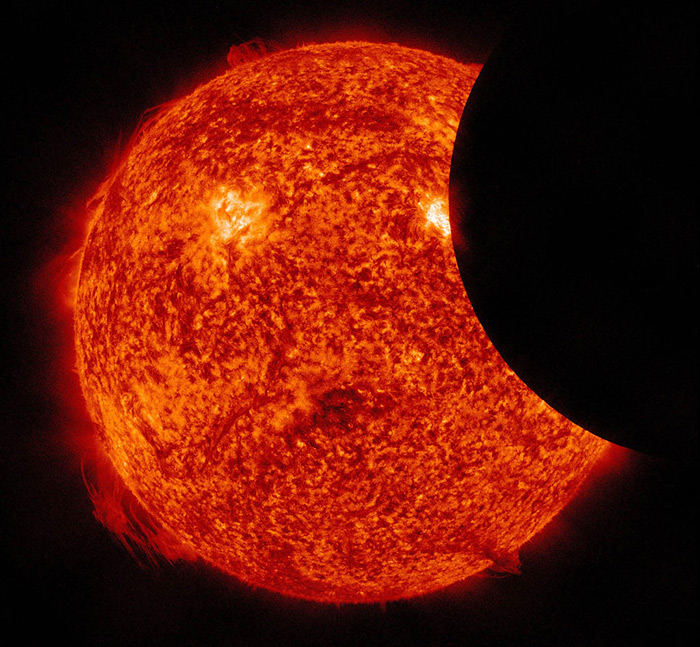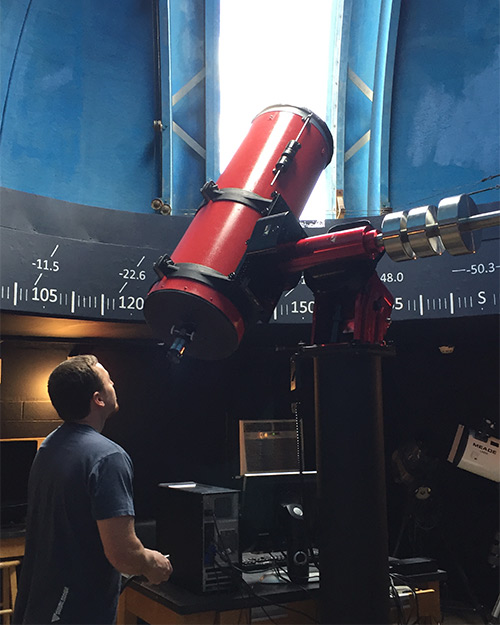Event Features Telescopes, Safety Glasses and Observatory Tours
Eclipse Viewing on Campus – Aug 21
Times: 11:45 a.m.-2:45 p.m. (Maximum Coverage of Sun ~1:16 p.m.
Locations:
- Lawn between Science & Research 1 Building and Science Engineering Classrooms (map)
- UH Observatory, Science & Research 1 Building
- Lawn between the Classroom and Business Building and Student Center North
On August 21, the solar eclipse will make its way across the country. Along this pathway, which starts in Oregon and ends in Georgia, the moon will block the sun completely for a few minutes at a time.
 Photo: NASA/GSFC/SDOIn Houston, starting at approximately 11:46 AM and ending at 2:45 PM, the moon will
block the sun at a maximum of 67 percent. Solar eclipses are rare, with the last total
eclipse in the continental U.S. taking place in 1979.
Photo: NASA/GSFC/SDOIn Houston, starting at approximately 11:46 AM and ending at 2:45 PM, the moon will
block the sun at a maximum of 67 percent. Solar eclipses are rare, with the last total
eclipse in the continental U.S. taking place in 1979.
August 21 is also the first day of the fall semester, meaning that for new students, their first day at UH will truly be a once-in-a-solar-eclipse event.
Multiple Ways to View Eclipse
To celebrate this rare occurrence, the Astronomy Society of the University of Houston will host viewing opportunities in the grassy area between Science and Research 1 (SR1) and the Science and Engineering Classroom Building (SEC). There will be a second viewing location on the lawn between the Classroom and Business Building (CBB) and the Student Center North (SCN).
At the demonstration tent, they will set up telescopes with solar filters and pinhole projection assemblies that enable safe viewing of the sun. Thanks to funds provided by the College of Natural Sciences and Mathematics, there will also be a safety goggle station where people can view the eclipse with the naked eye.
The UH Observatory on top of SR1 will also be open to students, faculty and staff. Visitors can view the eclipse through the big telescope and tour the facility.
“We hope to help people understand more about what a solar eclipse is, and how it happens,” said Fre’Etta Brooks, a senior physics major, and the president of the Astronomy Society.
Observatory Renovated by Astronomy Society
The UH observatory, which was out of commission for several years, is now operational thanks to the hard work of the Astronomy Society, and the financial support of the Department of Physics. During the renovations, which were initiated and supervised by curator Susan Street and former co-curator Carlos Gramajo, the Astronomy Society refurbished the observatory and repaired much of the equipment.
 The mount installation, paid for by the physics department, is an automatic steering
mount which allows for a high accuracy of tracking objects across the sky and enables
long-term viewing of moving objects.
The mount installation, paid for by the physics department, is an automatic steering
mount which allows for a high accuracy of tracking objects across the sky and enables
long-term viewing of moving objects.
Since 2016, the Astronomy Society has grown to 70 members, hosting monthly meetings,
bringing in guest lecturers, and holding regular observation nights. Earlier this
year, during one of these observation nights, participants were able to spot Jupiter
during its ascension, when the planet was at its brightest. Its characteristic spot,
or big eye, was visible through the telescope.
“During the solar eclipse demonstrations, we want visitors to learn that the observatory
is a great campus resource, and that the Astronomy Society is a welcoming society,
open to all majors,” Brooks said.
Susan Street serves as the curator for the observatory, assistant professor of physics Andrew Renshaw serves as faculty advisor for the observatory and associate professor of physics Donna Stokes serves as faculty advisor for the Astronomy Society.
- Rachel Fairbank, College of Natural Sciences and Mathematics
Parking Information: Potential visitors should note that this is the first day of classes at UH, with heavy traffic throughout the day. Although the viewing is free, visitor parking, located in the Stadium Garage on Holman St, charges an hourly fee. People might consider other potential viewing opportunities such as: